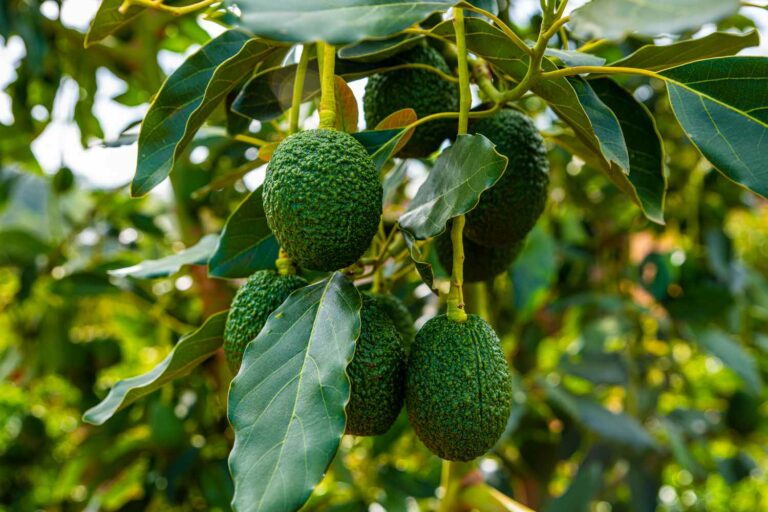Welcome to the world of avocado trees (Persea americana), the tall, evergreen fruit trees that are not only known for their creamy and delicious fruits but also for their ornamental value. If you live in the southern tip of the United States or further south, you have the unique opportunity to grow an avocado tree outdoors in your garden. These trees can reach great heights – much greater heights than the Laceleaf Weeping Japanese Red Maple – and are best known for their thick, bright green foliage and abundant health benefits.
It is important to note that while the fruit of the avocado tree is beloved by humans, all parts of the tree, including the fruit, are toxic to a wide range of animals. So if you have pets, it is best to keep them away from the tree.
Common Avocado tree varieties:
- Hass: The Hass avocado is one of the most popular varieties and is known for its black, pebbled skin and rich, creamy flesh.
- Fuerte: The Fuerte avocado has smooth, green skin and a buttery, nutty flavor.
- Reed: The Reed avocado is a large, round fruit with smooth, green skin and a creamy texture.
Care
To care for an avocado tree, it is important to pay attention to light and soil, ensuring the tree receives at least 8 hours of sunlight and well-draining soil with a pH of 5 to 7. Adding a layer of mulch can help retain moisture. Infrequent, deep watering is best, waiting until the soil begins to dry out before watering. Avocado trees thrive in temperatures between 50 and 85 degrees Fahrenheit, with a humid environment, and are sensitive to frost. Though they can only grow outdoors in tropical and subtropical regions, they can be grown indoors elsewhere.
- Light: at least 8 hours of (preferably direct) sunlight a day
- Soil: well-draining soil with a pH of 5 to 7
- Water: water deeply when the soil dries out (especially in warmer months)
- Temperature: these trees thrive in temperatures between 50 and 85 degrees Fahrenheit, with a humid environment
Propagation
Avocado trees can be propagated by two main methods: growing from seed (just like you would grow tomatoes, pumpkins or Jalapenos) or grafting.
Growing from seed involves sprouting an avocado pit, which is an enjoyable and easy project for gardeners. However, it’s important to note that the resulting tree might not produce identical fruit to its parent.
Grafting involves attaching a cutting from a mature avocado tree to a rootstock, which creates a new tree that will be the same as the parent tree. Avocado trees can also be grown in pots, which is great for smaller gardens or areas with cold weather.
For potted avocado trees, make sure to use well-draining soil and a container with proper drainage. Happy gardening!
Common Pests
- Persea Mite
- Polyphagous Shothole Borer
- Avocado Brown Mite
- Avocado Thrips
- Greenhouse Thrips
- Omnivorous Looper
- Amorbia
Pruning
Giving your avocado plant a little trim can work wonders! Pruning helps control its height and encourages branching, which leads to a fuller plant. Avocado plants have a tendency to grow with a single tall shoot and few leaves, but with some early pruning, you can change that.
Springtime is the best season to grab your trusty pair of sharp scissors. Simply snip off the top of the main shoot, right below the upper leaves. This will trigger branching, and your avocado plant will start sprouting from that point.
Don’t forget to apply the same technique to any well-developed side shoots. Just make sure your avocado plant is at least 30 cm tall and has a good number of leaves before you begin your pruning adventure.
Frequently Asked Questions
When it comes to growing avocados, patience is truly the key to success. Whether you decide to start with a seed or a nursery-grown tree, it will take some time for your tree to bear fruit. If you plant a tree, you’ll have to wait for three to four years before you can start enjoying its delicious fruits. But, if you choose to start with a seed, you may have to wait for a whopping 13 years or more!
What time of year do avocados grow best?
These days, this fruit is available all year round. But, for those who truly appreciate the divine flavor and texture of this fruit, January through March is the prime time to indulge. During this period, avocados have developed a higher oil content, resulting in that delectable, buttery taste and texture that we all adore.
Are Avocado trees toxic?
A delicious treat for humans, but one that we should be careful with when it comes to our furry and feathered friends. Did you know that avocados contain a substance called persin that can be harmful to dogs, and can cause vomiting and diarrhea? And it’s not just our canine companions that we need to be mindful of – birds, horses, and rodents are particularly sensitive to avocado toxicity due to differences in their digestive systems. So let’s enjoy our avocados responsibly and make sure to keep them out of reach of our animal friends.
Will avocados ripen faster in the sun?
Avocado experts at Avocados from Mexico recommend placing the fruit in direct sunlight, which can help accelerate the natural ripening process. So, the next time you’re waiting for your avocados to ripen, try placing them in a sunny spot and watch the magic happen!

